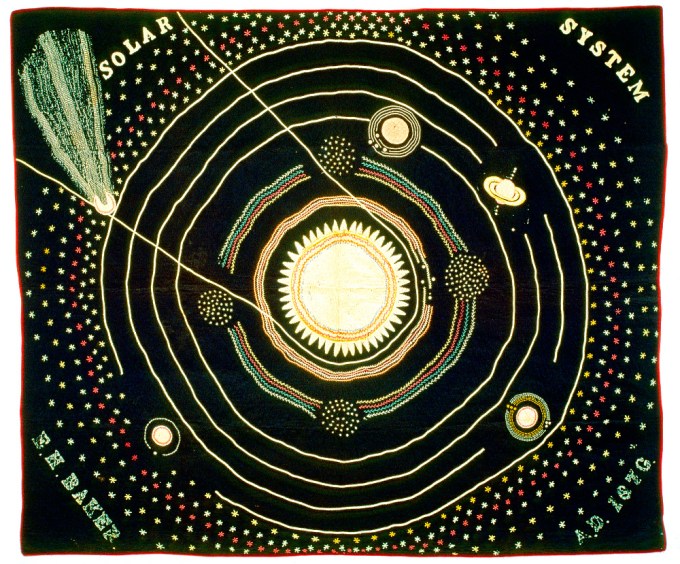Encounters with the beautiful and the sublime in the science of “the single most dangerous object known to humanity.”
On July 13, 1862, while a young experiment in democracy was being ripped asunder by its first Civil War, The Springfield Republican reported a strange and wondrous celestial sighting in the undivided sky, as bright as Polaris. Within days, two astronomers — Lewis Swift and Horace Parnell Tuttle — independently observed the phenomenon and determined it to be a colossal comet. Comet Swift-Tuttle — the largest Solar System object to periodically pass near Earth — is now known to return every 133 years, dragging in its long wake a dazzling annual gift: Each summer, as our lonely planet crosses the orbit of Swift-Tuttle and the debris shed by the icy colossus burn up in our atmosphere, the Perseid meteor shower streaks across the common sky, washing the whole of humanity with wonder.
19th-century Solar System quilt featuring a comet, designed and embroidered by Ellen Harding Baker over the course of seven years to teach women astronomy when they were barred from higher education in science. (Available as a print and a face mask, benefitting the endeavor to build New York City’s first public observatory.)
For millennia, the Perseids have lit up the summer sky in an annual celestial spectacle — one of the most staggering on Earth, with as many as 200 vibrant meteors per hour — that just befell the awestruck human animal without known cause or cosmic correlation. Some thought the streaks of light were debris from volcanic eruptions in faraway lands falling back to Earth. Others, including most scientists well into the nineteenth century, believed they were atmospheric phenomena like rainbows and lightning. Their cometic origins were unknown and comets themselves were a mystery. For astronomers — even for Caroline Herschel, who became the world’s first professional female astronomer thanks to her prolific and perilous comet-hunting — they were little more than a diversion, a flexing of tenacity, a competitive game of discovery that advanced personal reputations rather than elemental truth. More than a century before Carl Sagan and Ann Druyan shed light on the still-unsolved science of comets, very little was understood about these mysterious visitors from outer space. The poetic science writer Emma Converse — the Carl Sagan of her epoch — prophesied that someday, “with a powerful grasp, like that of Newton, some watcher of the stars shall seize the secret of cometic history.”
One of French artist and astronomer Étienne Léopold Trouvelot’s stunning 19th-century paintings of celestial objects and phenomena. (Available as a print and as a face mask, benefitting the endeavor to build New York City’s first public observatory.)
That day began dawning in the small hours of November 13, 1833. Neighbors awoke neighbors with shouts of excitement as people gathered in the street to watch a rain of fire from beneath the invisible umbrella of the night. Shooting stars blazed across the dark sky at the breath-stilling rate of thousands, tens of thousands per minute. All of this was puzzling: It was November, not August; the meteors were falling at manyfold the rate of the annual summer Perseids; and, at so high a density, they seemed to be streaming from a single source far from Earth, challenging the accepted notion that meteors were atmospheric phenomena.
Denison Olmsted (Portrait by Reuben Son of Moulthrop. Smithsonian Libraries.)
Among the stunned spectators was the esteemed Yale mathematician, astronomer, and “natural philosopher” Denison Olmsted. (He couldn’t yet be called a “scientist” — the word was coined a year later for the polymathic Scottish mathematician Mary Somerville.) Like most of his colleagues, Olmsted had largely ignored meteors as uninteresting minor curiosities, irrelevant to astronomy and better left to meteorology. Now, he was seized with the sense that they might have cosmic origins and might therefore hold clues to the celestial mechanics of the universe. But he knew his personal observations that night hardly constituted data.
The following morning, two years after the polymathic astronomer John Herschel — the era’s most venerated patron saint of science — made his pioneering case for citizen science, Olmsted drafted a letter and sent it to the local newspaper in New Haven, appealing to ordinary people to help him “collect all the facts attending this phenomenon… with as much precision as possible” by reporting anything they could recall about the time, orientation, and speed of the shooting stars they had witnessed. The announcement was quickly reprinted in newspapers across the country and responses began pouring in.
Art from Thomas Wright’s revolutionary 1750 book An Original Theory or New Hypothesis of the Universe. (Available as a print and as a face mask, benefitting the endeavor to build New York City’s first public observatory.)
Drawing on these observations, Olmsted was able to ascertain that the spectacle in Earth’s sky had cosmic rather than atmospheric origins and to locate its point of emergence — poetically known as radiant — in the constellation Leo. And so the Leonid showers ushered in the dawn of meteor science as a field of astronomy rather than meteorology.
But even with the origin point located, the cause of meteor showers remained a mystery. It took another generation to discover that fiery pageants like the Perseids and the Leonids are the debris of passing comets. Today, the Leonids are known to be the flotsam of Comet Tempel-Tuttle, visible from Earth every 33 years. It was independently discovered in 1865–1866, on its next passage after the 1833 triumph of citizen science, by the astronomers Wilhelm Tempel and Horace Parnell Tuttle — the same Tuttle who two years earlier had co-discovered the cometic originator of the Perseids, so named because in 1835, the Belgian astronomer and statistician Adolphe Quetelet — founder of Brussels Observatory and creator of the Body Mass Index scale — had located the radiant of the annual summer meteor showers in the constellation Perseus.
Art by Sophie Blackall from If You Come to Earth.
That fateful July of 1862, when newspaper reports of the strange celestial apparition that became Comet Swift-Tuttle interrupted for a moment the stream of death-tolls from the battlefields of the American Civil War, a young comet-hunter in another revolution-torn country elsewhere on the globe was also following the bright light advancing across the common sky — the Italian astronomer and historian of science Giovanni Schiaparelli, born the year the Perseids got their name.
Within a few years of obsessive scholarship, Schiaparelli arrived at a startling hypothesis: meteor showers might be the tails of passing comets. With astrophotography newly born and the instruments of science advancing rapidly in a Golden Age of telescopic astronomy, his hypothesis was proven correct, conferring upon comets a new aura of interest for science.
Art from Kometenbuch [The Comet Book], 1587. (Available as a print.)
As more and more came to be understood about these icy boomerangs from the outer reaches of the Solar System, the enormous and proximate Comet Swift-Tuttle — which comes closer to the Earth-Moon system than any other: a mere 130 kilometers at its perihelion, less than twenty times the distance between Europe and America — took on an ominous air, looming larger and larger in the popular imagination as a potential destroyer of Earth, invoking the same instincts that had prompted our Medieval ancestors to view comets as demonic omens before the birth of the scientific method and astronomy as we know it.
A calculation in the 1990s suggested that the comet’s passage on August 14, 2126 could result in a collision with Earth. By the end of the decade, Comet Swift-Tuttle was deemed “the single most dangerous object known to humanity,” given the damage it would inflict in case of actual collision — an impact many times more powerful than that of the asteroid that killed the dinosaurs, with a trillion times the energy of the Hiroshima atomic bomb.
Our Sun and Moon in proportion to their diameters, alongside two comets, from Thomas Wright’s An Original Theory or New Hypothesis of the Universe. (Available as a print and as a face mask, benefitting the endeavor to build New York City’s first public observatory.)
But the threat turned out to reveal more about the workings of the human mind than about the workings of the universe, more reflective of our instinct to fear what we don’t fully understand than of a scientific reality. The 1990s were the dawn of a new Golden Age of science — one driven by digital computation and rapidly advancing data technologies.
Calculations of Comet Swift-Tuttle’s orbital period and tilt have been continually refined since its discovery in 1862, as scientists have peered backward in time with the telescope of scholarship to identify sightings and positions as early 69 BC, and have telescoped forward in spacetime with computational astrophysics to predict when and how close to Earth it will come in the future. We (“we,” if our species survives its plurality) can expect a close encounter with Comet Swift-Tuttle when it returns to the inner Solar System in the year 3044 — “close” being a relative proximity on the cosmic scale and a distant one million miles in the absolute.
Should these calculations too prove to be incorrect — for science is always improving and, as Richard Feynman astutely observed, “it is impossible to find an answer which someday will not be found to be wrong” — and should the comet one day shatter our lonely planet after all, it will have given us millennia of wonder and transcendence, slaking the human soul with its summer spectacle of otherworldly beauty.
The Leonid meteor showers of 1833. Art by Edmund Weiss from Bilder Atlas der Sternenwelt [Image Atlas of the Star World], 1888. (Available as a print and as a face mask, benefitting the endeavor to build New York City’s first public observatory.)
donating = loving
For 15 years, I have been spending hundreds of hours and thousands of dollars each month to keep Brain Pickings going. It has remained free and ad-free and alive thanks to patronage from readers. I have no staff, no interns, no assistant — a thoroughly one-woman labor of love that is also my life and my livelihood. If this labor makes your life more livable in any way, please consider aiding its sustenance with donation.
newsletter
Brain Pickings has a free weekly newsletter. It comes out on Sundays and offers the week’s most inspiring reading. Here’s what to expect. Like? Sign up.





